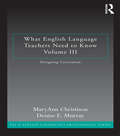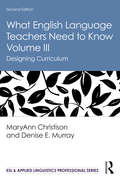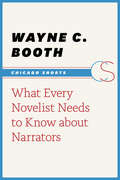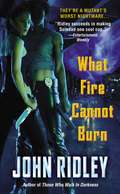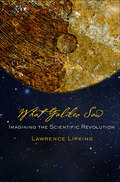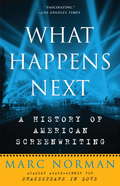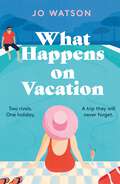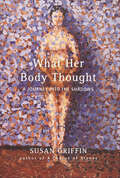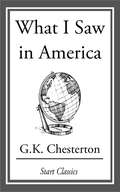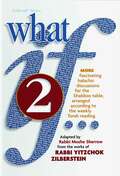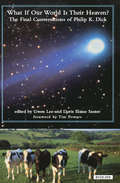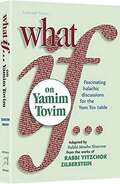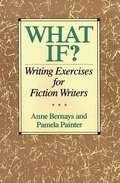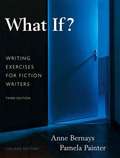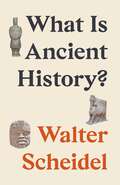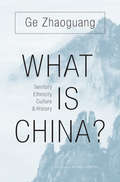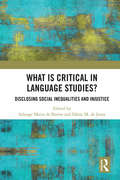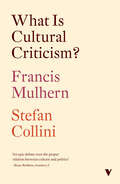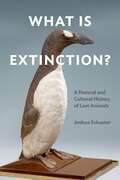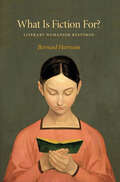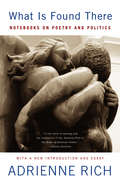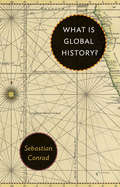- Table View
- List View
What English Language Teachers Need to Know Volume III: Designing Curriculum
by MaryAnn Christison Denise E. MurrayWhat English Teachers Need to Know, a set of companion texts designed for pre-service teachers and teachers new to the field of ELT, addresses the key question: What do English language teachers need to know and be able to do in order for their students to learn English? These texts work for teachers across different contexts (countries where English is the dominant language, one of the official languages, or taught as a foreign language); different levels (elementary/primary, secondary, college or university, or adult education); and different learning purposes (general English, workplace English, English for academic purposes, or English for specific purposes). Volume I, on understanding learning, provides the background information that teachers need to know and be able to use in their classroom. Volume II, on facilitating learning, covers the three main facets of teaching: planning, instructing, and assessing. Volume III, on designing curriculum, covers the contexts for, processes in, and types of ELT curricula—linguistic based, content-based, learner-centered, and learning-centered. Throughout the three volumes, the focus is on outcomes, that is, student learning. Features • Situated in current research in the field of English language teaching and other disciplines that inform it • Sample data, including classroom vignettes • Three kinds of activities/tasks: Reflect, Explore, and Expand
What English Language Teachers Need to Know Volume III: Designing Curriculum (ESL & Applied Linguistics Professional Series)
by MaryAnn Christison Denise E. MurrayDesigned for pre-service and novice teachers in ELT, What English Language Teachers Need to Know Volumes I, II, and III are companion textbooks organized around the key question: What do teachers need to know and be able to do in order to help their students to learn English?Thoroughly revised and updated, the second edition of Volume III explores the contexts for ELT curricula; explains key processes in curriculum design; and sets out approaches to curricula that are linguistic-based, content-based, learner centered, and learning centered. Organized around the three pillars of teaching—planning, instructing, and assessing—chapters in the second edition are updated to include current research and theory to meet the needs of today’s teachers, and feature new or revised vignettes and activities. New chapters help teachers understand both the technological and multilingual approaches that learners need to succeed today. The comprehensive texts of this series are suitable resources for teachers across different contexts—where English is the dominant language, an official language, or a foreign language; for different levels—elementary/primary, secondary, university, or adult education; and for different learning purposes—general English, workplace English, English for academic purposes, or English for specific purposes.
What Error Correction Can(not) Accomplish for Second Language Writers: DIspelling Myths, Discussing Options
by Dana R. Ferris"I took a powerful lesson away from that first classroom experience, one that has shaped my subsequent teaching of L2 composition, my teacher training, my research, and my writing: It is simply not possible to get a whole class of student writers from Point A (wherever they start out) to Point B (perfect, error-free papers) by the end of one writing course." ---Dana R. Ferris This content has been updated and expanded upon since originally appearing as Myth 5 in Writing Myths: Applying Second Language Research to Classroom Teaching, edited by Joy Reid, in 2008. This BEST OF MICHIGAN ELT ebook covers three aspects of L2 research that influence error correction: Second language acquisition takes time. Second language writers' texts are different from those written by native English speakers. Even diligent teacher correction and student editing does not lead to perfect, error-free texts. In clear and simple terms, Ferris makes six suggestions for things teachers can do in the classroom regarding error correction and provides samples. Three detailed appendixes complement this discussion. The book closes by addressing the basic principles of developing students' language skills in second language/ESL writing classes. Other issues regarding the expectations of students and others--such as in timed (high-stakes) situations--as it relates to "perfect" papers are examined.
What Every Novelist Needs to Know about Narrators
by Wayne C. BoothWayne Booth transformed the study of fiction in the twentieth century and wrote some of the most influential and engaging criticism of our time. In What Every Novelist Needs to Know about Narrators, Booth tackles one of the most difficult issues writers of fiction face: the choice of which narrative approach to take in their work. With trademark Booth aplomb, he articulates the methods behind dramatization, character development, and point of view that are indispensable for successful writing. How far the narrator sees, how she or he thinks, and how those thoughts connect with--or diverge from--those of the reader, writer, or other characters in the story: these are tools that are key to narration, and here Booth considers them in this worthy selection.
What Fire Cannot Burn
by John RidleyThe bestselling author of "Those Who Walk in Darkness" delivers the second book of his action-packed series, featuring top LAPD mutant-hunter Soledad O'Roark, who teams up with rival Eddi Aoki when a vigilante starts killing metanormals without mercy. Original.
What Galileo Saw: Imagining the Scientific Revolution
by Lawrence LipkingThe Scientific Revolution of the seventeenth century has often been called a decisive turning point in human history. It represents, for good or ill, the birth of modern science and modern ways of viewing the world. In What Galileo Saw, Lawrence Lipking offers a new perspective on how to understand what happened then, arguing that artistic imagination and creativity as much as rational thought played a critical role in creating new visions of science and in shaping stories about eye-opening discoveries in cosmology, natural history, engineering, and the life sciences. When Galileo saw the face of the Moon and the moons of Jupiter, Lipking writes, he had to picture a cosmos that could account for them. Kepler thought his geometry could open a window into the mind of God. Francis Bacon's natural history envisioned an order of things that would replace the illusions of language with solid evidence and transform notions of life and death. Descartes designed a hypothetical "Book of Nature" to explain how everything in the universe was constructed. Thomas Browne reconceived the boundaries of truth and error. Robert Hooke, like Leonardo, was both researcher and artist; his schemes illuminate the microscopic and the macrocosmic. And when Isaac Newton imagined nature as a coherent and comprehensive mathematical system, he redefined the goals of science and the meaning of genius. What Galileo Saw bridges the divide between science and art; it brings together Galileo and Milton, Bacon and Shakespeare. Lipking enters the minds and the workshops where the Scientific Revolution was fashioned, drawing on art, literature, and the history of science to reimagine how perceptions about the world and human life could change so drastically, and change forever.
What Happens Next: A History of American Screenwriting
by Marc NormanShakespeare in Love screenwriter Norman offers a history of his Hollywood predecessors and contemporaries, the famously despised screenwriters. Stories include the fallout of the McCarthy-era blacklists, the introduction of the Production Code and writers' attempts to outsmart the censors, the disappointment of director Billy Wilder upon hiring master crime novelist Raymond Chandler to script Double Indemnity (later nominated for a Best Screenplay Oscar), and the redefining of screenwriting by the likes of Quentin Tarantino and Charlie Kaufman. Annotation ©2008 Book News, Inc. , Portland, OR (booknews. com)
What Happens On Vacation: The brand-new enemies-to-lovers rom-com you won't want to go on holiday without!
by Jo WatsonTwo rivals. One holiday. A trip they will never forget.Jo Watson returns with a hilarious and heartfelt new enemies-to-lovers, forced-proximity rom-com! It's the book you won't want to go on holiday without! Perfect for fans of Emily Henry, Beth O'Leary and Christina Lauren..........................................Journalist Margaret needs a vacation. After a difficult couple of years, some R&R is on the cards, and she's taking her mom with her. Luckily, the office Quiz Night is coming up and the prize is an all-expenses-paid trip to Zanzibar. Good thing Margaret has never met a quiz question she didn't like. But Margaret has also never played against Jagger Villain. For the last six months, they have shared a desk and not a day has gone by when he hasn't driven her to distraction. The idea of sharing anything else with Jagger is unthinkable. But if she's going get what she needs from this trip, Margaret might have to compromise. Away from the office and in a tropical paradise, Margaret beings to wonder if her archnemesis maybe has some qualities. Could the holiday from hell turn into the vacation of her dreams? .........................................Love funny, romantic stories? You don't want to miss Jo Watson:'The perfect choice for fans of romantic comedies' Gina's Bookshelf'It was amazing, it was hilarious' Rachel's Random Reads'A brilliant read from beginning to end' Hopeless Romantics'Sitting here open mouthed in disbelief at just how wonderful this book is' Rachel's Random Reads'A stunning heart-warming read' Donna's Book Blog
What Her Body Thought: A Journey Into the Shadows
by Susan GriffinIn this boldly intimate and intelligent blend of personal memoir, social history, and cultural criticism, Susan Griffin profoundly illuminates our understanding of illness. She explores its physical, emotional, spiritual, and social aspects, revealing how it magnifies our yearning for connection and reconciliation.Griffin begins with a gripping account of her own harrowing experiences with Chronic Fatigue and Immune Dysfunction Syndrome (CFIDS), a potentially life-threatening illness that has been misconstrued and marginalized through the label "psychosomatic." Faced with terrifying bouts of fatigue, pain, and diminished thinking, the shame of illness, and the difficulty of being told you are "not really ill," she was driven to understand how early childhood loss made her susceptible to disease.Alongside her own story, Griffin weaves in her fascinating interpretation of the story of Marie du Plessis, popularized as the fictional Camille, an eighteenth-century courtesan whose young life was taken by tuberculosis. In the old story, Griffin finds contemporary themes of "money, bills, creditors, class, social standing, who is acceptable and who not, who is to be protected and who abandoned." In our current economy, she sees "how to be sick can impoverish, how poverty increases the misery of sickness, and how the implicit violence of this process wounds the soul as well as the body."Griffin insists that we must tell our stories to maintain our own integrity and authority, so that the sources of suffering become visible and validated. She writes passionately of a society where we are all cared for through "the rootedness of our connections. How the wound of being allowed to suffer points to a need to meet at the deepest level, to make an exchange at the nadir of life and death, the giving and taking which will weave a more spacious fabric of existence, communitas, community." Her views of the larger problems of illness and society are deeply illuminating.
What I Saw in America
by G. K. ChestertonJournalist, novelist, poet, artist and art critic, essayist, theologian, propagandist, philosopher, and creator of the wily old Father Brown - G. K. Chesterton is one of the most beguiling authors of the early twentieth century. When asked to perform a lecture tour in 1921, Chesterton was in a slump of depression. He had recently lost his brother to the First World War and his wavering faith in the face of the horrors of the conflict only intensified his malaise. 'What I Saw in America' tells us as much about the author and his particular views as it does about his destination. Indeed, Chesterton's personalised observations - his aversion to imperialism, capitalism, Anglo-Americanism and his commitment to democracy and fraternity - are distinguished by the piercing wit for which he is famed. Many of Chesterton's reflections are timeless and startlingly prescient. He was highly critical of both the naive immigration policies and the grinding dehumanisation brought about by the growth of the economy. Nonetheless, he was enthralled by the glorious ideals of the nation - founded on principles of equality, democracy and freedom - even if the essence of these ideals had been lost somewhere along the way. 'What I Saw in America' ranks among the finest of Chesterton's works, containing all of the author's virtues and vices: his wry humour, sympathy and intelligence playing devilishly against an irrepressible mischievousness.
What If 2: More Fascinating Halachic Discussions for the Shabbos Table, Arranged According to the Weekly Torah Reading
by Moshe SherrowWhat if... <p><p> ...a mohel is running late, and the bris will not be performed on time unless he breaks the speed limit on a major highway? <p><p> ...a person buys a hat, and the "cashier" turns out to be a thief who had simply sat at the cash register - does he have to pay the store again? <p><p> ...a man hired to say Kaddish does so faithfully, and finds out at the end of eleven months that he's gotten the name of the deceased wrong? <p><p> These are all true stories. All real-life halachic questions. And all absolutely fascinating. <p><p> Jews the world over have discovered the perfect conversation-starter at their Shabbos table: What If? Based on the popular Hebrew-language series Chashukei Chemed, written by noted rav and posek, Rav Yitzchok Zilberstein shlita, and translated and arranged in the order of the weekly parashah by Rabbi Moshe Sherrow, What If? includes hundreds of real-life halachic questions, each accompanied by a brief, practical scenario to illustrate the case, and an analysis that is understandable and easy to follow. <p><p> What If? garnered immense acclaim because it reaches people of all ages and backgrounds. The queries, stories, and halachic explanations are clear and simple, so that even youngsters can discuss them (and guess at the answers - a sure conversation starter!). At the same time these fascinating halachic questions and responses hold the interest of those well-versed in Torah scholarship. <p><p> Since its publication, What If? has become a beloved guest at thousands of Shabbos tables - and readers have been clamoring for more. What If? Volume 2 continues the Torah conversation, with still more unusual and engrossing questions and cases. <p><p> Let the conversation at your Shabbos table flow as smoothly as fine wine, with What If? Volume 2.
What If Our World Is Their Heaven?: The Final Conversations of Philip K. Dick
by Philip K. Dick, Gwen Lee, and Doris Elaine SauterInterviews with the genius behind The Man in the High Castle and countless other science fiction classics. In the field of science fiction, Philip K. Dick is unparalleled. His novel Do Androids Dream of Electric Sheep? became the classic film Blade Runner. His short story &“The Minority Report&” was adapted for the screen by Steven Spielberg. The Man in the High Castle has become a hit series on Amazon, and those titles represent only a small fraction of his work. In November 1982, six months before the author&’s untimely death, journalist Gwen Lee recorded the first of several in-depth discussions with Philip K. Dick that continued over the course of the next three months. This transcription is a fascinating read for anyone interested in the field of science fiction. &“These transcripts bring fresh insights—notably, into the imaginative biotech plot line of the unwritten The Owl in Daylight . . . Dick also discusses music, writing, philosophers and his 1974–1975 mystical visions, when the revelation of his son&’s undiagnosed birth defect—&‘down to anatomical details&’—saved the child&’s life . . . Fans will rejoice.&” —Publishers Weekly
What If: Fascinating Halachic Discussions for the Yom Tov Table
by Moshe SherrowYou love it at your Shabbos table. Now you can enjoy What If? on all the Jewish holidays! <p><p>It is Rosh Hashanah. A man holding a shofar is going to blow it for a sick friend. A car pulls up and the driver says, “I'm Jewish. Would you mind blowing that shofar for me? Should he blow the shofar while yom tov is clearly being desecrated? <p><p>Boaz built a huge succah for his restaurant—and now patrons of other kosher eateries are using it, and his own customers have to wait. Can he ask the others to leave? <p><p>A pre-Pesach food drive is hurting local groceries. Can the merchants demand that the food distribution be stopped? <p><p>The bestselling and beloved What If? series has become a welcome staple at our Shabbos tables. Based on the popular Hebrew-language series Chashukei Chemed, written by noted rav and posek Rav Yitzchok Zilberstein shlita, and translated and arranged by Rabbi Moshe Sherrow, every volume in the What If? series includes hundreds of real-life halachic questions, each accompanied by a brief, practical scenario to illustrate the case, and an answer that is understandable and easy to follow. Make your holiday table extra-special with the great conversation starter, What If on Yamim Tovim.
What If? Writing Exercises for Fiction Writers (1st edition)
by Anne Bernays Pamela PainterA handbook for writers based on the idea that specific exercises are one of the most useful and provocative methods of mastering the art of fiction writing
What If? Writing Exercises for Fiction Writers (College Edition, 3rd Edition)
by Anne Bernays Pamela PainterThis book is comprised primarily of exercises introduced by brief but informative essays on the aspects of fiction. This text provides a practical, hands-on approach to writing fiction. Organized by the elements of fiction and concluded by an anthology of contemporary fiction, this book helps all fiction writers hone and improve their craft.
What If?: Twenty-Two Scenarios in Search of Images
by Vilém FlusserAn imagination of possibilities, of miscalculations, of futures off-kilter &“Probability is a chimera, its head is true, its tail a suggestion. Futurologists attempt to compel the head to eat the tail (ouroboros). Here, though, we will try to wag the tail.&” —Vilém Flusser Two years after his Vampyroteuthis Infernalis, the philosopher Vilém Flusser engaged in another thought experiment: a collection of twenty-two &“scenarios for the future&” to be produced as computer-generated media, or technical images, that would break the imaginative logjam in conceiving the social, political, and economic future of the universe. What If? is not just an &“impossible journey&” to which Flusser invites us in the first scenario; it functions also as a distorting mirror held up to humanity. Flusser&’s disarming scenarios of an Anthropocene fraught with nightmares offer new visions that range from the scientific to the fantastic to the playful and whimsical. Each essay reflects our present sense of understanding the world, considering the exploitation of nature and the dangers of global warming, overpopulation, and blind reliance on the promises of scientific knowledge and invention. What If? offers insight into the radical futures of a slipstream Anthropocene that have much to do with speculative fiction, with Flusser&’s concept of design as &“crafty&” or slippery, and with art and the immense creative potential of failure versus reasonable, &“good&” computing or calculability. As such, the book is both a warning and a nudge to imagine what we may yet become and be.
What If…?: Fascinating Halachic Discussions for the Shabbos Table, Arranged According to the Weekly Torah Reading
by Moshe SherrowWhat If... makes a wonderful addition to our Shabbos table. Rav Yitzchok Zilberstein shlita is a noted rav and posek, as well as a son-in-law of Rav Elyashiv zt'l. <p><p>What If... presents hundreds of halachic questions and answers in the order of the weekly parashah, making it the perfect starting point for fascinating Torah conversations. The questions are short, and each includes a practical, real-world scenario. The answers, too, are concise, and though they contain a world of Torah knowledge, they are easy to follow. <p><p>A man jokingly tells his friend to microwave an esrog to make it ripen quickly - who is responsible for the damage? A surgeon learns a new technique from a presentation, without paying the entrance fee. May he use that technique, or is it stealing? A mother doesn't want to reveal her child's illness, thus keeping people from praying for him. Is that permitted? <p><p>Challenge your family or guests with these thought-provoking halachic questions, and watch the energy around the table begin to surge. This is Torah conversation at its best.
What Is Ancient History?
by Walter ScheidelFrom one of today&’s most innovative ancient historians, a provocative new vision of why ancient history matters—and why it needs to be told in a radically different, global wayIt&’s easy to think that ancient history is, well, ancient history—obsolete, irrelevant, unjustifiably focused on Greece and Rome, and at risk of extinction. In What Is Ancient History?, Walter Scheidel presents a compelling case for a new kind of ancient history—a global history that captures antiquity&’s pivotal role as a decisive phase in human development, one that provided the shared foundation of our world and continues to shape our lives today.For Scheidel, ancient history is when the earliest versions of today&’s ways of life were created and spread—from farming, mining, and engineering to housing and transportation, cities and government, writing and belief systems. Transforming the planet, this process unfolded all over the world, in Eurasia, Africa, and the Americas, often at different times, sometimes haltingly but ultimately unstoppably. Yet it&’s rarely studied or taught that way. Since the eighteenth century, Western intellectuals have dismembered the ancient world, driven not only by their quest for professional expertise but also by nationalism, colonialism, racism, and the idealization of Greece and Rome. Specialized scholarship has fractured into numerous academic niches, obscuring broader patterns and dynamics and keeping us from understanding just how much humanity has long had in common.The time has come, Scheidel argues, to put the ancient world back together—by moving beyond the limitations of Greco-Roman &“classics,&” by systematically comparing ancient societies, and by exploring early exchanges and connections between them. The time has come, in other words, for an ancient history for everyone.
What Is China?: Territory, Ethnicity, Culture, and History
by Ge ZhaoguangGe Zhaoguang, an eminent historian of traditional China and a public intellectual, takes on fundamental questions that shape the domestic and international politics of the world’s most populous country and its second largest economy. What Is China? offers an insider’s account that addresses sensitive problems of Chinese identity and shows how modern scholarship about China—whether conducted in China, East Asia, or the West—has attempted to make sense of the country’s shifting territorial boundaries and its diversity of ethnic groups and cultures. Ge considers, for example, the ancient concept of tianxia, or All-Under-Heaven, which assigned supremacy to the imperial court and lesser status to officials, citizens, tributary states, and tribal peoples. Does China’s government still operate with a belief in divine rule of All-Under-Heaven, or has it taken a different view of other actors, inside and outside its current borders? Responding both to Western theories of the nation-state and to Chinese intellectuals eager to promote “national learning,” Ge offers an insightful and erudite account of how China sees its place in the world. As he wrestles with complex historical and cultural forces guiding the inner workings of an often misunderstood nation, Ge also teases out many nuances of China’s encounter with the contemporary world, using China’s past to explain aspects of its present and to provide insight into various paths the nation might follow as the twenty-first century unfolds.
What Is Critical in Language Studies: Disclosing Social Inequalities and Injustice
by Solange Maria de Barros; Dánie M. de JesusThis volume examines the notion of criticality in language studies. Drawing on the work of the Frankfurt School – Adorno, Habermas, Horkheimer, and Marcuse, among others – the chapters in the volume examine a variety of linguistic contexts: from gender activism to web journalism, from the classroom to the open streets. It also presents theoretical and methodological guidelines to researchers interested in • Expanding their critical outlook for meaning brought on by the notion of criticality in contemporary language studies. • Understanding criticality in languages through historical, political, and social perspectives. • Using linguistics and language studies as tools to dissect and disclose social injustices. This book will be of great interest to scholars and researchers of language studies and linguistics, philosophy, politics, and sociology and social policy.
What Is Cultural Criticism?
by Stefan Collini Francis MulhernTwo leading critics grapple with problems of literature, politics and intellectual practiceIn What Is Cultural Criticism?, two leading critics grapple with problems of literature, politics and intellectual practice. The debate opens with Francis Mulhern&’s account of what he terms &‘metacultural discourse&’. This embraces two opposing critical traditions, the elite pessimism of Kulturkritik and the populist enthusiasms of Cultural Studies. Each in its own way dissolves politics into culture, Mulhern argues. Collini, on the other hand, protests that cultural criticism provides resources for genuine critical engagement with contemporary society. Tension between culture and politics there may be, but it works productively in both directions.This widely noticed encounter is that rare thing, a sustained debate in which, as Collini remarks, the protagonists not only exchange shots but also ideas. It concludes with Mulhern&’s engagement with Collini&’s writing on the subordination of universities to metrics and bureaucracy, and a companion rejoinder from Collini on Mulhern&’s study of the &‘condition of culture novel&’ and his essays on questions of nationality and the politics of intellectuals.
What Is Extinction?: A Natural and Cultural History of Last Animals
by Joshua SchusterWINNER, 25th ANNUAL SUSANNE M. GLASSCOCK BOOK PRIZELife on Earth is facing a mass extinction event of our own making. Human activity is changing the biology and the meaning of extinction. What Is Extinction? examines several key moments that have come to define the terms of extinction over the past two centuries, exploring instances of animal and human finitude and the cultural forms used to document and interpret these events.Offering a critical theory for the critically endangered, Joshua Schuster proposes that different discourses of limits and lastness appear in specific extinction events over time as a response to changing attitudes toward species frailty. Understanding these extinction events also involves examining what happens when the conceptual and cultural forms used to account for species finitude are pressed to their limits as well. Schuster provides close readings of several case studies of extinction that bring together environmental humanities and multispecies methods with media-specific analyses at the terminus of life.What Is Extinction? delves into the development of last animal photography, the anthropological and psychoanalytic fascination with human origins and ends, the invention of new literary genres of last fictions, the rise of new extreme biopolitics in the Third Reich that attempted to change the meaning of extinction, and the current pursuit of de-extinction technologies. Schuster offers timely interpretations of how definitions and visions of extinction have changed in the past and continue to change in the present.
What Is Fiction For?: Literary Humanism Restored
by Bernard HarrisonHow can literature, which consists of nothing more than the description of imaginary events and situations, offer any insight into the workings of "human reality" or "the human condition"? Can mere words illuminate something that we call "reality"? Bernard Harrison answers these questions in this profoundly original work that seeks to re-enfranchise reality in the realms of art and discourse. In an ambitious account of the relationship between literature and cognition, he seeks to show how literary fiction, by deploying words against a background of imagined circumstances, allows us to focus on the roots, in social practice, of the meanings by which we represent our world and ourselves. Engaging with philosophers and theorists as diverse as Wittgenstein, Sartre, Merleau-Ponty, Foucault, Derrida, F. R. Leavis, Cleanth Brooks, and Stanley Fish, and illustrating his ideas through readings of works by Swift, Woolf, Appelfeld, and Dickens, among others, this book presents a systematic defense of humanism in literary studies, and of the study of the Humanities more generally, by a distinguished scholar.
What Is Found There: Notebooks on Poetry and Politics (Expanded Edition)
by Adrienne RichAmerica's enduring poet of conscience reflects on the proven and potential role of poetry in contemporary politics and life. Through journals, letters, dreams, and close readings of the work of many poets, Adrienne Rich reflects on how poetry and politics enter and impinge on American life. This expanded edition includes a new preface by the author as well as her post-9/11 "Six Meditations in Place of a Lecture."
What Is Global History?
by Sebastian ConradUntil very recently, historians have looked at the past with the tools of the nineteenth century. But globalization has fundamentally altered our ways of knowing, and it is no longer possible to study nations in isolation or to understand world history as emanating from the West. This book reveals why the discipline of global history has emerged as the most dynamic and innovative field in history--one that takes the connectedness of the world as its point of departure, and that poses a fundamental challenge to the premises and methods of history as we know it.What Is Global History? provides a comprehensive overview of this exciting new approach to history. The book addresses some of the biggest questions the discipline will face in the twenty-first century: How does global history differ from other interpretations of world history? How do we write a global history that is not Eurocentric yet does not fall into the trap of creating new centrisms? How can historians compare different societies and establish compatibility across space? What are the politics of global history? This in-depth and accessible book also explores the limits of the new paradigm and even its dangers, the question of whom global history should be written for, and much more.Written by a leading expert in the field, What Is Global History? shows how, by understanding the world's past as an integrated whole, historians can remap the terrain of their discipline for our globalized present.
